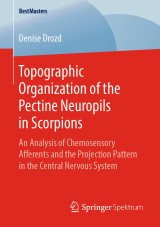Details

Topographic Organization of the Pectine Neuropils in Scorpions
An Analysis of Chemosensory Afferents and the Projection Pattern in the Central Nervous SystemBestMasters
|
53,49 € |
|
| Verlag: | Spektrum Akademischer Verlag bei Elsevier |
| Format: | |
| Veröffentl.: | 17.01.2019 |
| ISBN/EAN: | 9783658251550 |
| Sprache: | englisch |
Dieses eBook enthält ein Wasserzeichen.
Beschreibungen
<div>Chelicerates do not possess dedicated antennae like the Mandibulata but have evolved their second sets of appendages into the eponymous chelicerae. In scorpions, pectines are specialized comb-like structures, located on the ninth body segment, used for examining the substrate for chemo- and mechanosensory signals. The comb teeth, or pegs, are truncated beveled structures facing the substrate for probing, and are studded with numerous sensory receptors. Afferents from the pectines project into a distinct neuropil of the central nervous system, located behind the fourth walking leg neuropils. Denise Drozd analyzes afferents of single pegs in <i>Mesobuthus eupeus</i> by backfilling, combined with immunohistological labeling of neuropil regions. Her results suggest a topographic representation of the chemosensory fibers within the pectine neuropil instead of the typical chemotopic representation.</div><div><br></div>
The Nervous System of Scorpions.- Structural Analysis of the Posterior Pectine Neuropil.- Projection Areas of Chemosensory Afferents.<div><br></div>
<div>Denise Drozd is a PhD candidate of Prof. Dr. Harald Wolf at the Institute of Neurobiology at Ulm University, Germany. </div><div><br></div>
<div>Chelicerates do not possess dedicated antennae like the Mandibulata but have evolved their second sets of appendages into the eponymous chelicerae. In scorpions, pectines are specialized comb-like structures, located on the ninth body segment, used for examining the substrate for chemo- and mechanosensory signals. The comb teeth, or pegs, are truncated beveled structures facing the substrate for probing, and are studded with numerous sensory receptors. Afferents from the pectines project into a distinct neuropil of the central nervous system, located behind the fourth walking leg neuropils. Denise Drozd analyzes afferents of single pegs in <i>Mesobuthus eupeus</i> by backfilling, combined with immunohistological labeling of neuropil regions. Her results suggest a topographic representation of the chemosensory fibers within the pectine neuropil instead of the typical chemotopic representation.</div><div><br></div><div><b>Contents</b></div><div><ul><li>The Nervous System of Scorpions<br></li><li>Structural Analysis of the Posterior Pectine Neuropil<br></li><li>Projection Areas of Chemosensory Afferents<br></li></ul></div><div><b>Target Groups</b><br></div><div>Lecturers and students in the fields of neurobiology, morphology, and zoology<br></div><div><b><br></b></div><div><b>The Author</b><br></div><div>Denise Drozd is a PhD candidate of Prof. Dr. Harald Wolf at the Institute of Neurobiology at Ulm University, Germany. </div><div><br></div>
A neuroanatomical analysis
Diese Produkte könnten Sie auch interessieren:

Auditory Signal Processing

von: Daniel Pressnitzer, Alain de Cheveigne, Stephen McAdams, Lionel Collet

213,99 €















